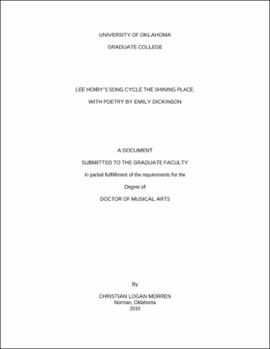| dc.contributor.advisor | Magrath, Jane | |
| dc.creator | Morren, Christian Logan | |
| dc.date.accessioned | 2019-04-27T21:26:40Z | |
| dc.date.available | 2019-04-27T21:26:40Z | |
| dc.date.issued | 2010 | |
| dc.identifier | 99196815002042 | |
| dc.identifier.uri | https://hdl.handle.net/11244/318710 | |
| dc.description.abstract | LEE HOIBY'S SONG CYLE THE SHINING PLACE, | |
| dc.description.abstract | WITH POETRY BY EMILY DICKINSON | |
| dc.description.abstract | BY: CHRISTIAN MORREN | |
| dc.description.abstract | MAJOR PROFESSOR: JANE MAGRATH, D.M. | |
| dc.description.abstract | The purpose of this study is to investigate the compositional style and influences on Lee Hoiby and to document the importance of the work The Shining Place by Lee Hoiby in art song literature. The cycle consists of five Dickinson poems set by Hoiby. The title of the song cycle, The Shining Place, is taken from the name of the first song in the set which is dedicated to soprano Cynthia Miller. The four following songs in the set are "A Letter," "How the Waters Closed," "Wild Nights," and "There Came a Wind Like a Bugle." | |
| dc.description.abstract | The first piece in the cycle "How the Waters Closed" was composed in 1954 and the completed cycle was performed initially in 1989 with Hoiby on the piano and soprano Cynthia Miller as soloist. While no relationship between the poems exists, the poetry is filled with text painting and Hoiby's trademark presentations of florid piano parts as a strong duet accompaniment for the singer. | |
| dc.description.abstract | This document investigates the compositional style of the The Shining Place and provided insights on various influences on Lee Hoiby. Personal interviews with Hoiby and Virgina Dupuy form the basis of much of the material presented here. The frequency of Hoiby's works appearing in the university and opera halls in America underscores the importance of providing documentation and analysis of his major works such as The Shining Place. | |
| dc.description.abstract | The study is organized into five chapters and begins an introduction to the study. Biographical information on Lee Hoiby is presented in chapter two. The next chapter includes discussions on Emily Dickinson and other American composers who have set Dickinson's poetry to music. The fourth chapter provides a musical analysis of the song cycle The Shining Place with an emphasis on the unique aspects of Hoiby's compositional techniques that make this song cycle significant in American art song repertoire. The final chapter contains a summary, reflections, and suggestions for further research. Appendices include transcripts from the interviews with Lee Hoiby and Virginia Dupuy and the poetry from The Shining Place. | |
| dc.format.extent | 128 pages | |
| dc.format.medium | application.pdf | |
| dc.language | en_US | |
| dc.relation.requires | Adobe Acrobat Reader | |
| dc.subject | Musical analysis | |
| dc.title | Lee Hoiby's Song Cycle The Shining Place, With Poetry by Emily Dickinson | |
| dc.type | text | |
| dc.type | document | |
| dc.thesis.degree | D.M.A. | |
| ou.group | Weitzenhoffer Family College of Fine Arts::School of Music | |
